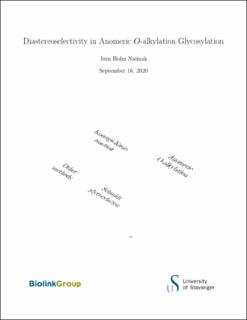| dc.contributor.advisor | Bakstad, Einar | |
| dc.contributor.author | Naimak, Jørn Holm | |
| dc.date.accessioned | 2021-02-08T13:43:13Z | |
| dc.date.available | 2021-02-08T13:43:13Z | |
| dc.date.issued | 2021-02 | |
| dc.identifier.citation | Diastereoselectivity in Anomeric O-alkylation Glycosylation by Jørn Holm Naimak, Stavanger : University of Stavanger, 2021 (PhD thesis UiS, no. 570) | en_US |
| dc.identifier.isbn | 978-82-7644-983-9 | |
| dc.identifier.issn | 1890-1387 | |
| dc.identifier.uri | https://hdl.handle.net/11250/2726645 | |
| dc.description.abstract | Biosynth AS used anomeric O-alkylation of α-haloacetophenones in their patented total synthesis of anthocyanins from 2006. There were, however, several challenges with stereoselectivity and yields when performing this glycosylation on a large scale. The goal of this Ph.D. has been to investigate anomeric O-alkylation. The first glycosylation method was developed in 1869, yet chemists still face challenges with glycosylation. An example of a popular glycosylation method widely utilized in chemical industries is the Schmidt glycosylation, a technique which does not necessarily provide high -stereoselectivity and high yields in α-glycosylation. It is also not necessarily the most economically feasible glycosylation method. This work adds another piece to the puzzle of glycosylation. More insight into how solvents and bases influence strereoselectivity and yields in anomeric O-alkylation was uncovered in this work. Tetramethyl urea (TMU) was found to be a superior solvent for α-glycosylation compared to N,N-dimethylformamide (DMF). This finding could have wide applications, since DMF is the preferred solvent for many reactions that require a highly polar aprotic solvent. The advantage of TMU over DMF became less significant when larger amounts of solvent was used. For β-glycosylation, toluene was found to be a suitable alternative to dichloromethane (DCM), which also is more safe to use on large scale with strong bases. Of the bases that were investigated, Cs2CO3 and 1,8-diazabicyclo[5.4.0]undec-7-ene (DBU) were found to favor α-glycosylation, while LiH and NaH were found to favor β-glycosylation. Decreasing the temperature seemed to marginally increase β-glycosylation, but prevented the reaction from occurring altogether in less polar solvents. Raising the temperature increased α-glycosylation marginally, but unfortunately it more significantly increased the production of pentaacetate 34 as a byproduct. Halogenated acetophenones with electron donating groups (EDG) in the para position were shown to be more reactive in anomeric O-alkylation than halogenated acetophenones with electron withdrawing groups (EWG) in the para position. These results are in agreement with studies on nucleophilic substitution of α-haloketones, which indicates that the mechanistic pathway for producing glycosides is in competition with another mechanistic pathway for producing acyloins. | en_US |
| dc.language.iso | eng | en_US |
| dc.publisher | University of Stavanger, Norway | en_US |
| dc.relation.ispartofseries | PhD thesis UiS; | |
| dc.relation.ispartofseries | ;570 | |
| dc.subject | naturvitenskap | en_US |
| dc.subject | kjemi | en_US |
| dc.title | Diastereoselectivity in Anomeric O-alkylation Glycosylation | en_US |
| dc.type | Doctoral thesis | en_US |
| dc.rights.holder | (C) Jørn Holm Naimak | en_US |
| dc.subject.nsi | VDP::Matematikk og Naturvitenskap: 400::Kjemi: 440 | en_US |
